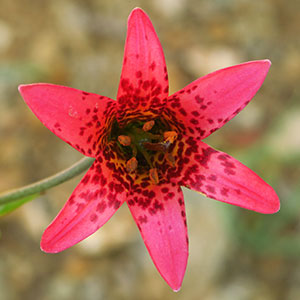Lilium bolanderi
Lilium kelleyanum
Bolander's lily
Kelley's lily
± ovoid, 3.5–7.9 × 2.6–5.3 cm, 0.9–2.1 times taller than long;
scales unsegmented, longest 3–5.7 cm;
stem roots absent.
rhizomatous, unbranched, continuously scaly, 1.4–3.1 × 3.8–8.2 cm, 0.3–0.6 times taller than long;
scales 2–3-segmented, a few unsegmented, longest 0.8–2.7 cm;
stem roots absent.
to 1.1 m, glaucous.
to 2.2 m. Buds rounded in cross section.
rounded in cross section.
in 1–5(–6) whorls or partial whorls, 3–19 leaves per whorl, ascending and often cupping stem, 1.8–7.1 × 0.7–2.8 cm, 2.2–4.8 times longer than wide;
blade ± obovate, oblanceolate, or occasionally elliptic, noticeably glaucous, margins nearly always undulate, apex widely acute;
veins and margins ± smooth abaxially.
scattered or usually in 1–4 whorls or partial whorls, 3–10 leaves per whorl, horizontal and drooping at tips, 7.8–15.8 × 1.1–5.3 cm, 3.2–10.8 times longer than wide;
blade usually elliptic, occasionally weakly lanceolate or oblanceolate, margins not undulate, apex narrowly acute;
veins and margins ± smooth abaxially.
usually umbellate in small plants, in large plants racemose or in 2 whorls, 1–9-flowered.
racemose, 1–15(–25)-flowered.
nodding to horizontal, not fragrant;
perianth ± campanulate or funnelform;
sepals and petals somewhat recurved 3/5–4/5 along length from base, red or magenta, occasionally salmon pink or pale yellow, with maroon spots, often yellowish on proximal 1/3–1/2, not distinctly clawed;
sepals not ridged abaxially, 3.1–4.7 × 0.7–1.2 cm;
petals 3–4.5 × 0.7–1.1 cm;
stamens included;
filaments barely spreading, diverging 0°–12° from axis;
anthers reddish or magenta, 0.3–0.8 cm;
pollen rust, orange, or yellow;
pistil 2.1–3.5 cm;
ovary 1–2.1 cm;
style green, rarely reddish purple;
pedicel 0.8–14.2 cm.
pendent, mildly fragrant;
perianth Turk’s-cap-shaped;
sepals and petals reflexed 2/5 along length from base, yellow or yellow-orange, usually with copious maroon spots, not distinctly clawed;
sepals not ridged abaxially, 4.3–5.7 × 0.9–1.5 cm;
petals 4.2–5.7 × 0.9–1.5 cm;
stamens moderately exserted;
filaments moderately spreading, diverging 9°–19° from axis;
anthers magenta or dull red, 0.3–0.6 cm;
pollen pale orange, rust, orange, or tan-orange;
pistil 2.6–3.4 cm;
ovary 0.8–1.4 cm;
style green;
pedicel 8.5–20.7 cm.
2–4.1 × 1.2–2.1 cm, 1.4–3 times longer than wide.
1.5–2.9 × 1–1.9 cm, 1.1–2 times longer than wide.
90–210.
96–169.
= 24.
= 24.
Lilium bolanderi
Lilium kelleyanum
I. M. Johnston (1923) noted that Lilium bolanderi Watson was based on a mixed collection including L. kelloggii, and he argued that Watson intended the name to apply primarily to the latter species. Thus he proposed the name L. howellii for this diminutive, red-flowered, serpentine endemic. A. D. Cotton (1936) correctly concluded that Watson’s description applied primarily to the specimens here called L. bolanderi, and this view is now widely accepted.
Lilium bolanderi hybridizes with L. rubescens, L. washingtonianum subsp. purpurascens, and subspecies of L. pardalinum.
Bolander’s lily is primarily pollinated by Allen’s and rufous hummingbirds (Selasphorus spp., family Trochilidae).
(Discussion copyrighted by Flora of North America; reprinted with permission.)
Lilium kelleyanum has in common with L. parvum a short, relatively wide fruit and small flowers, and divides with that species the montane and subalpine Sierra Nevada on both sides of the divide from Lake Tahoe south. The two species are parapatrically distributed with an intervening zone of introgression; intergrades occur, among other places, in the June Lake region about ten miles south of Mono Lake in Mono County and in adjacent Madera County. The two species appear to be sister taxa (M. W. Skinner 1988), which argues against subsuming L. kelleyanum as a subspecies of L. pardalinum, as has been suggested by several students of the group. Despite the close affinity of L. kelleyanum to L. parvum, taxonomic custom within the genus dictates that they be retained as separate species since floral features are well differentiated.
Lilium kelleyanum is pollinated by swallowtail butterflies (J. S. Davis 1956).
(Discussion copyrighted by Flora of North America; reprinted with permission.)


